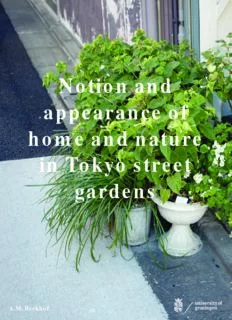
Notion and appearance of home and nature in Tokyo street gardens PDF
Preview Notion and appearance of home and nature in Tokyo street gardens
Notion and appearance of home and nature in Tokyo street gardens A.M. Berkhof Notion and appearance of home and nature in Tokyo street gardens A.M. Berkhof Amsterdam, August 2014 Masterthesis Architectural & Urban History University of Groningen Thesis supervisor: prof.dr.ir. Th. Spek professor of Landscape History, University of Groningen Thesis 2nd reader: dr. A.M. Martin associate professor of Architectural and Urban History, University of Groningen Preface This thesis would not have been possible without the help and support of many different people. Firstly the Van Eesteren-Fluck & Van Lohuizen Stichting supported me to be able to conduct fieldwork in Tokyo. When I visited the city I was warmly welcomed by Daphne Mohajer va Pesaran, Will Robinson, Miri Matsufuji, Thekla Boven, Jessica Jane Howard and Cameron Allen McLean, who all helped me to find my way in Tokyo in one way or another. I spoke to different people about my research, and learned a lot by dis- cussing it with them. Thank you Jessica Hammarlund Bergmann, Edwin Gardner, Christiaan Fruneaux, Vincent Schipper, Thijs Middeldorp, Daniel Ruigrok, Ellen van Holstein, Cameron Allen McLean, Julian Worrall, Thekla Boven, Joris Berkhout, Bram Nigten and Magdaleen Berkhof. Also many thanks to Aike Rots and Hajime Ishikawa for answering my questions and helping me find good sources for the theoretical framework. Lastly I would like to thank Jan Rothuizen for letting me use the beautiful drawing of his visit to a Japanese house and Monnik for giving me the op- portunity to experience Tokyo for the first time during their Still City Work- shop, and inspiring me to choose the street gardens as the subject of this research. Table of contents Chapter 1 - Introduction 12 1.1 Background of the research 13 1.2 State of the Art 17 1.3 Research questions 24 1.4 Sources and Methods 25 Part one – Context and theoretical framework Chapter 2 – The urban history of Tokyo 30 2.1 Introduction 31 2.2 Tokyo/Edo during Tokugawa (1603-1868) 33 - The Tokugawa era - High City Daimyo Samurai The low city within the high city - Low City Commoner’s alleys Bridges and squares - Whole City: a sense of scale Sense of Scale Sacred Green Space - The End of Edo 2.3 Tokyo before the Pacific War (1868-1940) 58 - The Meiji restoration: Modernization through imitation of the West New population Western influence - Taisho and Showa: The Kanto earthquake and the Japanese inter- pretation of the West Urban growth and the emergence of Contemporary Urban Life The Kanto earthquake - The legacy of Meiji, Taisho and Showa 2.4 Tokyo after the Pacific War (1940-1991) 70 - The Pacific War - Second half of Showa: Rebuilding the city in times of occupation - The Bubble Economy and the Lost Decade(s) - Present-day Tokyo Chapter 3 – Home: notions of home in Japan 84 3.1 Home in Tokyo 85 - Home in the Japanese city - Home in the megalopolis 3.2 Home and the house 93 - Uchi and soto - The traditional Japanese house - The modern Japanese house - The space around the house 3.3 Home and the street 106 3.4 Conclusion 107 Chapter 4 - Nature: notions of nature in Japan 110 4.1 Introduction 111 4.2 Traditional discourse on nature in Japan and the West 112 - Language and definition - The story of creation and religious thought on nature - Industrialization and traditional thought on nature 4.3 The myth of Japanese love of nature 120 - The myth - Japan’s problematic relation with the environment 4.4 Nature and artifice 128 - Nature in Japanese art and popular culture - Nature in Japanese gardens - Miniature aesthetic 4.5 Conclusion 145 Part two – Case studies Chapter 5 – Higashi Komagata and Yanaka 152 5.1 Introduction 153 - Study areas - Research questions - Methods 5.2 Case study 1: Higashi Komagata, Sumida-ku 159 - General characteristics - Streets, public space and greenery - Gardens 5.3 Case study 2: Yanaka 173 - General characteristics - Streets, public space and greenery - Gardens 5.4 Examples of the streets where the gardens are located 186 - Main road (Higashi Komagata) - Street with sidewalks (Higashi Komagata) - Shopping street (Yanaka) - Residential street (Higashi Komagata) - Alleyway (Yanaka) 5.5 Results 228 - The characteristics of the gardens - The functions of the gardens - The difference between gardens in a neighbourhood with a tradi- tional lay-out and a modernized lay-out - The reasons why inhabitants of Tokyo keep a garden 5.6 Discussion 235 - The meaning of the gardens - Attention for the gardens Part three – Synthesis and conclusions Chapter 6 - Synthesis 242 6.1 Introduction 243 6.2 Tokyo street gardens and the urban history of Tokyo 243 6.3 Tokyo street gardens and home 246 6.4 Tokyo street gardens and nature 250 Chapter 7 – Conclusion 254 Epilogue – The Plant Uniform 259 Bibliography 264 Figures 270
Description: